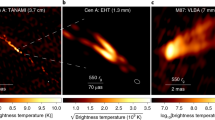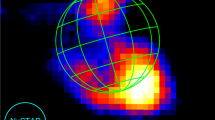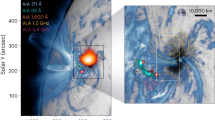Abstract
The well-defined zones of central meridian longitude within which the probability of jovian radio emission at frequencies near 22 MHz is relatively high are known as sources A, B and C. Each consists of a component for which the emission probability is strongly correlated with Io's orbital position, and another component that is Io-unrelated1. This emission anisotropy and other observed effects have long been interpreted in terms of quasi-continuous beams that co-rotate with the inner jovian magnetosphere. Observations made from the Soviet spacecraft Mars 7 and the Nancay Observatory2 provided more direct evidence for beaming; activity observed from one of the stations was not detectable from the other. We now present convincing evidence based on concurrent observations from the two Voyager spacecraft and a terrestrial observatory that the component of source A radiation that is not correlated with Io's position is generally emitted in co-rotating ‘searchlight beams’ of distinctive cross-sectional shape.
This is a preview of subscription content, access via your institution
Access options
Subscribe to this journal
Receive 51 print issues and online access
$199.00 per year
only $3.90 per issue
Buy this article
- Purchase on Springer Link
- Instant access to full article PDF
Prices may be subject to local taxes which are calculated during checkout
Similar content being viewed by others
References
Carr, T. D., Desch, M. D. & Alexander, J. K. in Physics of the Jovian Magnetosphere (ed. Dessler, A. J.) 226–284 (Cambridge University Press, 1983).
Poquerusse, M. & Lecacheux, A. Nature 275, 111–113 (1978).
Warwick, J. W. et al. Science 206, 991–995 (1979).
Leblanc, Y. J. geophys. Res. 86, 8564–8568 (1981).
Acuna, M. H. & Ness, N. F. J. geophys. Res. 81, 2917–2922 (1976).
Gulkis, S. & Carr, T. D. Science 154, 257–259 (1966).
Register, H. I. & Smith, A. G. Astrophys. Lett. 3, 209–213 (1969).
Carr, T. D., Smith, A. G., Donivan, F. F. & Register, H. I. Radio Source 5, 495–503 (1970).
Bozyan, F. A. & Douglas, J. N. J. geophys. Res. 81, 3387–3392 (1976).
Barrow, C. H. Astr. Astrophys. 101, 142–149 (1981).
Goldstein, M. L. & Thieman, J. R. J. geophys. Res. 86, 8569–8578 (1981).
Pearce, J. B. J. geophys. Res. 86, 8579–8580 (1981).
Staelin, D. H. J. geophys. Res. 86, 8581–8584 (1981).
Author information
Authors and Affiliations
Rights and permissions
About this article
Cite this article
Maeda, K., Carr, T. Beam structure of Jupiter's decametric radiation. Nature 308, 166–169 (1984). https://doi.org/10.1038/308166a0
Received:
Accepted:
Issue Date:
DOI: https://doi.org/10.1038/308166a0
This article is cited by
-
Beaming of Jupiter's decametric emission
Earth, Moon and Planets (1986)
Comments
By submitting a comment you agree to abide by our Terms and Community Guidelines. If you find something abusive or that does not comply with our terms or guidelines please flag it as inappropriate.



